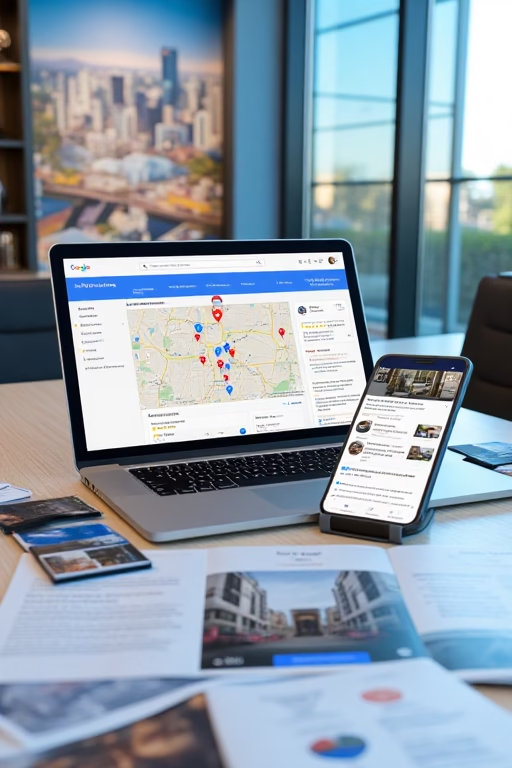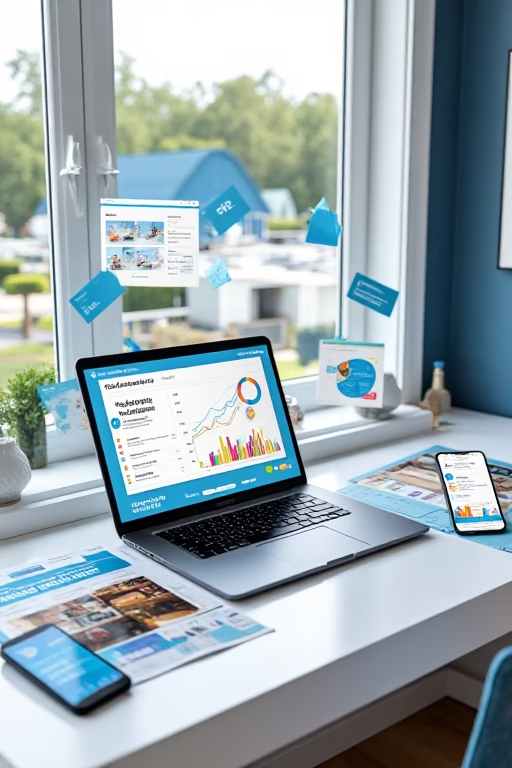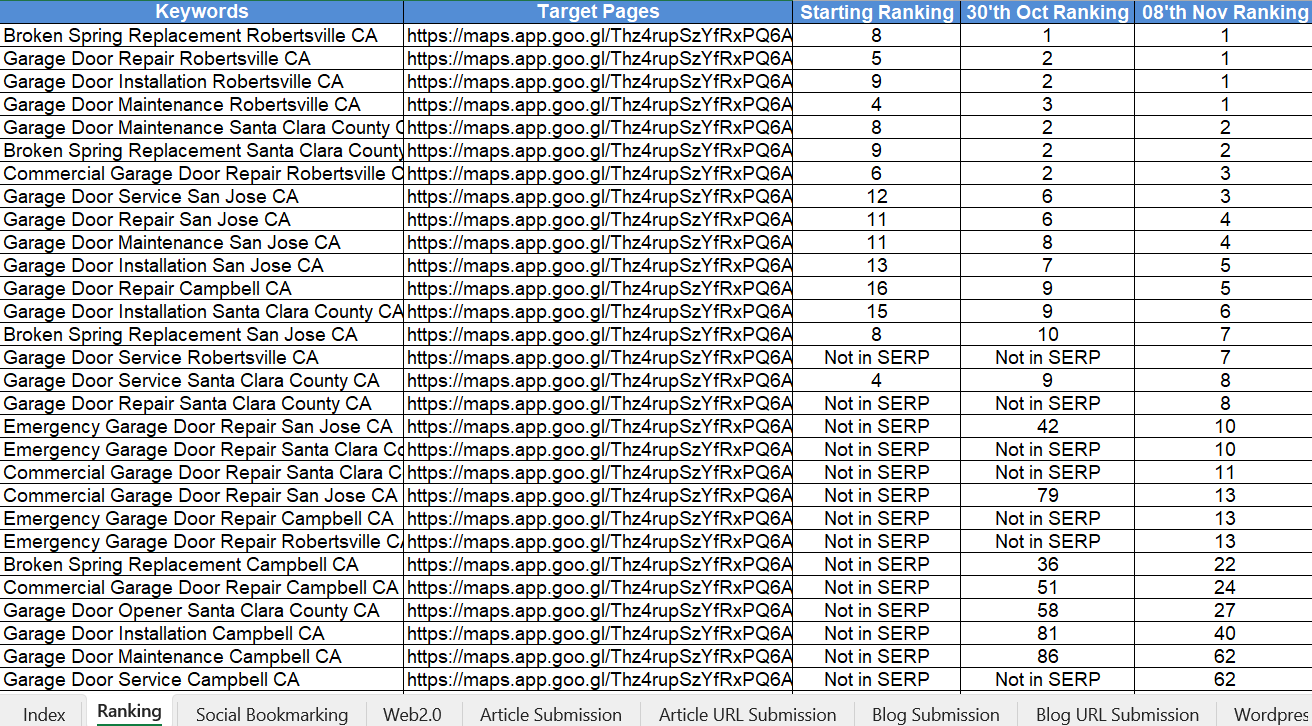Why Google My Business is a Goldmine for Commercial Real Estate Leads
Market Wiz
Your Ultimate Resource for Commercial Real Estate Marketing
Why Google My Business is a Goldmine for Commercial Real Estate Leads
Table of Contents
- Introduction: The Power of Google My Business in CRE
-
Google My Business Overview
- What is Google My Business?
- History and Evolution
- Key Features
-
Why GMB is a Lead Generation Goldmine
- Enhanced Local Visibility
- Customer Engagement & Trust
- Driving High-Quality CRE Leads
-
Optimizing Your Google My Business Listing
- Step-by-Step Setup
- Best Practices for CRE Professionals
- Visual Branding and Content
-
Leveraging Customer Reviews & Testimonials
- Importance of Reviews
- How to Solicit and Manage Feedback
- Case Studies
-
Using GMB Insights and Analytics
- Understanding the Data
- Improving Your Marketing Strategy
-
Integrating GMB with Other Marketing Channels
- Internal Linking with Market Wiz Resources
- External Resources and Tools
- Common Challenges and How to Overcome Them
- The Future of GMB in Commercial Real Estate
- Frequently Asked Questions (FAQs)
- Conclusion
Introduction: The Power of Google My Business in CRE
In today's fast-paced digital world, commercial real estate (CRE) professionals are continually looking for effective and low-cost strategies to generate quality leads. One tool that stands out as a game changer is Google My Business (GMB). Initially designed to help local businesses get discovered on Google Search and Maps, GMB has evolved into a dynamic platform that can significantly boost the visibility and credibility of commercial real estate listings and services.
At Market Wiz, we believe that harnessing the full potential of Google My Business is essential for any CRE professional who wishes to stay ahead of the competition. This comprehensive guide explores how GMB can be a goldmine for commercial real estate leads, outlining everything from its key features and benefits to optimization strategies and integration with other marketing channels.
Throughout this blog post, we will delve into detailed insights and actionable steps that will empower you to transform your GMB listing into a powerful lead-generation engine. Whether you're a seasoned real estate agent or a newcomer to the industry, this article will provide you with the tools you need to capitalize on one of Google's most potent local marketing platforms.
Google My Business Overview
What is Google My Business?
Google My Business is a free tool provided by Google that allows businesses to manage their online presence across the search engine and its growing network of maps, search, and discovery features. For commercial real estate professionals, a well-maintained GMB listing serves as a digital storefront that showcases your properties, services, and client success stories.
The platform is especially effective in improving local search rankings and providing essential business information, such as contact details, business hours, and customer reviews, which all play a crucial role in influencing potential leads. For a more technical overview, you can visit the official Google My Business Help Center.
History and Evolution
Launched in 2014, Google My Business was developed to provide businesses with an integrated platform to enhance their visibility on Google. Over the years, the tool has evolved to include a range of features such as customer reviews, Q&A, photos, and posts, which help businesses engage directly with their audience. For commercial real estate agents, these features offer an unprecedented opportunity to build a robust online presence and drive organic traffic to their listings.
The evolution of GMB reflects the changing dynamics of local search, with businesses now expected to maintain real-time updates and interact with customers directly. This transformation has made GMB an indispensable tool for local marketing, with its benefits extending far beyond simple business listings.
Key Features
Some of the most important features of Google My Business include:
- Business Profile: A complete profile that includes contact information, location, business hours, and services offered.
- Customer Reviews: A platform for customers to leave reviews and ratings, which build social proof and trust.
- Posts: The ability to publish updates, offers, events, and news directly on your GMB profile.
- Photos and Videos: Visual content that showcases your properties, office space, and successful transactions.
- Insights: Analytics that provide data on customer interactions, search queries, and overall engagement.
Understanding these features is critical for leveraging GMB as a lead-generation tool, especially in the competitive world of commercial real estate.
Why Google My Business is a Lead Generation Goldmine
Enhanced Local Visibility
For commercial real estate agents, local visibility is paramount. GMB optimizes your online presence by making your business easily discoverable on Google Search and Maps. When potential clients search for terms like "commercial real estate near me" or "office space for lease," a well-optimized GMB listing can place your business at the forefront of these search results.
This heightened visibility is especially beneficial for CRE professionals operating in competitive markets. By ensuring that your listing is complete and regularly updated, you are more likely to appear in Google's Local Pack, which highlights top businesses based on relevance, distance, and prominence. The result is an influx of organic leads who are actively searching for the services you offer.
Customer Engagement & Trust
The customer review system on GMB is a powerful trust signal. In an industry where credibility and reputation are essential, positive reviews can significantly enhance your online image. Each review serves as a testimonial that reinforces your expertise and reliability in the commercial real estate market.
Moreover, the Q&A feature allows potential clients to ask questions directly on your listing, enabling you to provide immediate answers and build rapport. Engaging with customers by responding to their reviews and queries not only improves your search ranking but also demonstrates a commitment to customer service. This proactive engagement can convert casual inquiries into serious leads.
Driving High-Quality CRE Leads
Google My Business is uniquely positioned to drive high-quality leads to your commercial real estate business. With detailed insights and user engagement metrics, GMB allows you to understand the behavior of potential clients and tailor your marketing strategies accordingly. The platform attracts local prospects who are more likely to be interested in your specific services, such as leasing, property management, or investment opportunities.
For instance, by analyzing the insights provided by GMB, you can identify peak search times and common queries related to commercial real estate. This data enables you to optimize your content strategy and ensure that your listing resonates with the target audience. Ultimately, the result is a steady stream of qualified leads that can be nurtured into long-term business relationships.
Optimizing Your Google My Business Listing
Step-by-Step Setup
Optimizing your Google My Business listing is a process that involves several critical steps. First, claim your listing by verifying your business through the Google My Business platform. This process typically involves receiving a postcard from Google with a verification code. Once verified, you can start filling out your profile in detail.
Here are some essential steps to follow:
- Claim and Verify Your Listing: Ensure that you have full control over your business profile by completing the verification process.
- Complete Your Profile: Add detailed information about your commercial real estate services, including your address, phone number, business hours, and website URL. For more on profile optimization, check out our SEO Guide on Market Wiz.
- Add High-Quality Visuals: Upload professional photos and videos of your properties, office environment, and team. Visual content is a key driver of engagement on GMB.
- Utilize Posts and Updates: Regularly post updates, news, and promotional content to keep your audience engaged. This also signals to Google that your business is active and relevant.
- Monitor and Respond to Reviews: Make it a habit to engage with customers by replying to their reviews and addressing any concerns promptly.
By following these steps, you not only enhance your listing’s appeal but also improve your chances of appearing in local search results.
Best Practices for CRE Professionals
When it comes to commercial real estate, it’s important to tailor your GMB strategy to meet the specific needs of your industry. Here are some best practices to consider:
- Use Industry-Specific Keywords: Incorporate keywords such as “commercial property,” “office space leasing,” and “industrial real estate” into your listing description and posts. This helps improve your listing’s relevancy to CRE searches.
- Highlight Unique Selling Points: Clearly articulate what sets your services apart from the competition. This might include special financing options, exclusive property listings, or award-winning service.
- Leverage Virtual Tours: Virtual tours are an excellent way to showcase your properties in detail. Embed these tours directly into your listing and website to provide a comprehensive view of what you offer.
- Stay Active: Regularly update your GMB profile with new photos, posts, and announcements. Consistency is key to maintaining high visibility and engagement.
For additional insights on digital marketing for real estate, visit our CRE Digital Marketing section on Market Wiz.
Visual Branding and Content
Your visual branding on Google My Business is a critical factor in attracting and retaining leads. High-quality images, professional videos, and consistent branding across all online platforms contribute to a cohesive and trustworthy image. This consistency not only reinforces your brand identity but also helps potential clients recognize your business when they come across it in search results.
Consider the following tips for visual branding:
- Invest in Professional Photography: High-resolution images of your properties and team can make a significant difference in the perception of your business.
- Design Custom Graphics: Use branded graphics and infographics to communicate key statistics, market trends, and unique selling propositions.
- Update Regularly: Keep your visuals current by uploading new photos and videos as your inventory and team evolve.
To learn more about creating effective visual content, check out this article on Forbes.
Leveraging Customer Reviews & Testimonials
Importance of Reviews in Commercial Real Estate
In commercial real estate, reputation is everything. Customer reviews on your GMB profile provide social proof that can significantly influence potential clients' decision-making. Positive reviews highlight your expertise, responsiveness, and success in managing commercial properties, which in turn builds trust among prospective leads.
Reviews also contribute to your overall search ranking on Google. A profile with numerous positive reviews is more likely to be favored in local search results, resulting in increased visibility and higher-quality leads.
How to Solicit and Manage Feedback
Encouraging satisfied clients to leave reviews is a strategic way to enhance your online reputation. Consider implementing the following strategies:
- Follow-Up Emails: After a successful transaction, send a personalized email requesting feedback and providing a direct link to your GMB profile.
- Incentivize Reviews: Offer a small token of appreciation—such as a discount on future services—for clients who leave a review. Ensure that any incentives comply with Google's policies.
- Engage with Feedback: Respond to both positive and negative reviews in a professional and timely manner. This demonstrates your commitment to customer satisfaction and helps build trust with prospective leads.
For more detailed guidance on managing online reviews, refer to this comprehensive resource on Search Engine Journal.
Case Studies: Success Stories from the CRE World
Many commercial real estate firms have successfully leveraged Google My Business to drive leads and increase their market share. For example, a mid-sized CRE firm in Chicago revamped its GMB profile by adding high-quality images, regular posts, and actively engaging with customer reviews. Within six months, the firm experienced a 40% increase in inquiries and a significant boost in property viewings.
Another success story comes from a boutique real estate agency specializing in office spaces. By focusing on local SEO and using GMB insights to adjust their posting schedule, the agency was able to attract a steady stream of investors looking for premium office locations. These case studies underscore the real-world effectiveness of a well-optimized Google My Business listing.
Using GMB Insights and Analytics
Understanding the Data Provided by GMB
Google My Business offers an array of analytical tools that provide valuable insights into how users are interacting with your listing. These insights include:
- Search Queries: Understand which keywords and phrases are driving traffic to your profile.
- User Actions: Track how many users visit your website, call your business, or request directions.
- Photo Views: Analyze the performance of your visual content in attracting potential leads.
- Customer Engagement: Measure the number and quality of customer reviews and interactions.
By carefully monitoring these metrics, CRE professionals can identify trends and make data-driven decisions to further optimize their marketing strategies. This proactive approach not only improves your online presence but also ensures that your GMB listing remains an effective lead-generation tool.
Improving Your Marketing Strategy with Analytics
GMB insights serve as a feedback loop that can guide your overall marketing strategy. For example, if you notice that a particular post or visual content receives a significant number of views, consider creating more content in a similar style. Conversely, if certain information on your profile remains overlooked, it may be time to revamp that section to better meet user expectations.
In addition, integrating GMB data with other marketing analytics tools, such as Google Analytics or CRM software, can provide a holistic view of your digital marketing performance. This comprehensive approach ensures that all aspects of your marketing strategy are aligned and optimized for lead generation.
Integrating GMB with Other Marketing Channels
Internal Linking with Market Wiz Resources
A key element of digital marketing success is creating a cohesive ecosystem where various channels support each other. By integrating your GMB listing with other digital assets, you can amplify your reach and enhance your lead-generation efforts. For example, linking your GMB profile to your website’s dedicated Case Studies page or your blog on SEO Tips not only drives traffic between platforms but also reinforces your expertise in commercial real estate.
External Resources and Tools
Beyond internal linking, leveraging external resources can significantly boost your digital marketing efforts. Consider linking to authoritative external sites such as the Google My Business page for the latest updates and best practices. Additionally, incorporating data or insights from trusted industry sources like Inman News or CRE Online can add credibility and depth to your content.
Common Challenges and How to Overcome Them
Despite its many benefits, optimizing and managing a Google My Business listing for commercial real estate can present several challenges. Common issues include:
- Inconsistent Information: Ensuring that all business details are accurate across various platforms can be time-consuming. Use tools like Yext to manage your business listings effectively.
- Negative Reviews: Negative feedback can harm your reputation if not managed properly. Develop a consistent review management strategy to address concerns and provide solutions.
- Keeping Content Fresh: The digital landscape is always changing, and outdated content can reduce the impact of your listing. Schedule regular audits of your GMB profile to ensure that all information, images, and posts remain current.
- Data Overload: With a wealth of insights available, it can be challenging to focus on the most impactful metrics. Prioritize key performance indicators (KPIs) that align with your lead-generation goals.
By acknowledging and addressing these challenges head-on, you can maintain a robust and effective GMB presence that continually drives quality leads to your business.
The Future of Google My Business in Commercial Real Estate
As the commercial real estate industry continues to evolve, so too will the tools and platforms that drive its success. Google My Business is already undergoing continuous updates to better serve businesses, and this trend is expected to accelerate in the coming years.
Emerging technologies such as artificial intelligence and machine learning are likely to enhance GMB’s ability to provide personalized insights and predictive analytics. For CRE professionals, staying ahead of these technological advancements will be critical to maintaining a competitive edge. By continuously optimizing your GMB listing and integrating it with other cutting-edge marketing tools, you can ensure that your lead generation strategies remain both innovative and effective.
Moreover, as more commercial real estate professionals recognize the power of a well-maintained GMB profile, competition in local search results is likely to intensify. This underscores the importance of investing time and resources into perfecting your online presence. The future belongs to those who can adapt to changing trends and harness the full potential of digital marketing platforms like Google My Business.
Frequently Asked Questions (FAQs)
1. How does Google My Business help generate leads in commercial real estate?
GMB enhances your local online visibility, making it easier for potential clients to find your business. It also provides social proof through customer reviews and interactive features that drive engagement.
2. What are the key elements of a well-optimized GMB listing?
A comprehensive GMB listing includes accurate business details, high-quality images, regular posts, and active engagement with customer reviews. Consistency across these elements is essential for maximizing your listing’s effectiveness.
3. How can I leverage customer reviews to boost my CRE leads?
Positive reviews build trust and credibility, which are crucial in the commercial real estate market. Encourage satisfied clients to leave feedback and respond promptly to all reviews to demonstrate your commitment to service.
4. Are there any tools that can help manage my GMB listing?
Yes, several tools such as Yext and BrightLocal can help manage and optimize your business listings across multiple platforms.
5. How often should I update my GMB listing?
Regular updates are key. Aim to review and refresh your listing at least once a month, and immediately update any changes in your business operations or contact information.
6. What role does mobile optimization play in GMB success?
With an increasing number of users accessing information on mobile devices, ensuring that your GMB listing is mobile-friendly is crucial. A seamless mobile experience helps capture leads on-the-go and enhances overall engagement.
7. Can GMB insights help improve my overall marketing strategy?
Absolutely. GMB insights provide valuable data on user behavior and search trends, which can be integrated with your broader marketing analytics to refine your strategies.
Conclusion
Google My Business has proven itself to be an indispensable tool for commercial real estate professionals seeking to generate high-quality leads without a heavy reliance on paid advertising. By optimizing your GMB listing, engaging with customers through reviews and Q&A, and leveraging the powerful analytics it provides, you can create a sustainable pipeline of leads that drives long-term business success.
At Market Wiz, we are dedicated to providing the insights and strategies you need to stay ahead in a competitive market. Whether you are just starting out or looking to refine your existing digital marketing strategy, the power of Google My Business should not be underestimated.
As we move further into the digital age, tools like GMB will continue to evolve, offering even more opportunities for engagement and lead generation. Embrace these changes, invest in optimizing your online presence, and watch as your commercial real estate business flourishes.
Remember, the journey to digital success is continuous. Keep learning, adapting, and leveraging every tool at your disposal, and you'll find that Google My Business truly is a goldmine for commercial real estate leads.
Final Thoughts
The digital marketing landscape is ever-changing, and commercial real estate professionals must adapt quickly to maintain their competitive edge. Google My Business offers a robust, cost-effective platform to enhance local visibility, engage with potential clients, and drive high-quality leads. By investing in a well-optimized GMB listing and integrating it with your broader marketing efforts, you can achieve lasting success in the dynamic world of commercial real estate.
This comprehensive guide has walked you through the numerous benefits of GMB—from its ability to boost local visibility and foster customer engagement to the practical steps you can take to optimize your listing and analyze performance. With actionable insights and real-world examples, we hope you feel empowered to harness the full potential of Google My Business.
For additional resources on commercial real estate marketing, be sure to explore our other articles on CRE Strategies and Digital Marketing Tips. We also recommend staying updated with industry trends by following reputable sources like Inman News and CRE Online.
Ultimately, the key to success is continuous learning and adaptation. As you implement these strategies, monitor your performance closely and adjust your approach to meet the evolving needs of your market. With dedication and the right tools at your disposal, Google My Business can be the catalyst that propels your commercial real estate business to new heights.
Why Google My Business is a Goldmine for Commercial Real Estate Leads Read More »













Harnessing the Power of Social Media & Content Marketing
Why Social Media Matters for CRE Agents
Social media platforms such as LinkedIn, Facebook, and Instagram are vital for connecting with property investors, tenants, and business owners. These channels help you share market insights, property listings, and success stories, thereby building your professional reputation.
Creating a Strategic Social Media Plan
Develop a content calendar tailored to your audience’s interests. Use a mix of posts, including property highlights, market updates, and behind-the-scenes looks at your operations to engage your audience consistently.
Blogging, Video Content, and Virtual Tours
Regularly publish blog posts and video content that offer valuable market analysis, investment tips, and property tours. Virtual tours can provide an immersive experience for potential clients, setting you apart from competitors.
Engagement and Analytics
Measure your social media performance through engagement metrics and adjust your strategy accordingly. Platforms like LinkedIn and Facebook provide insights that help refine your content and maximize reach.